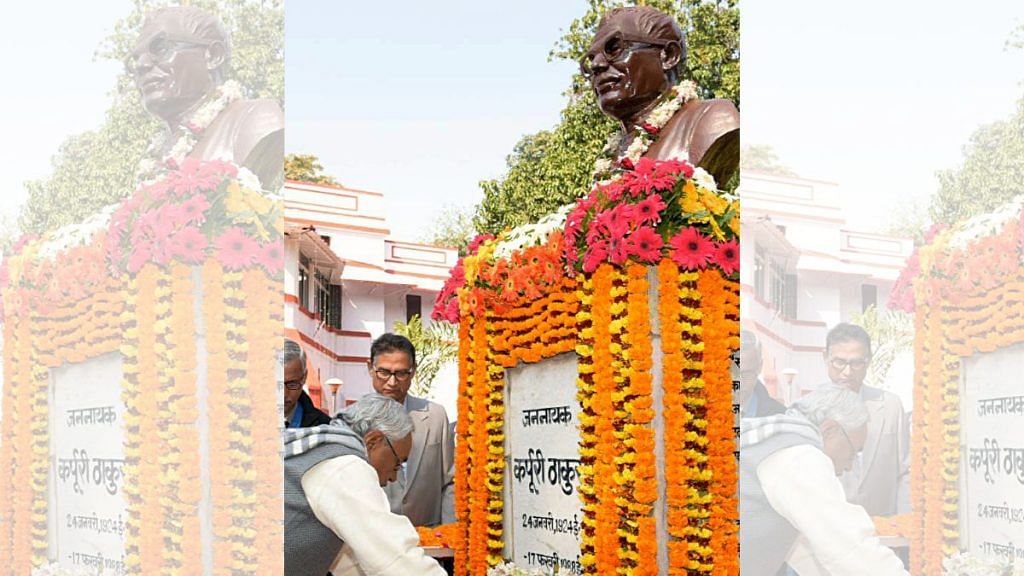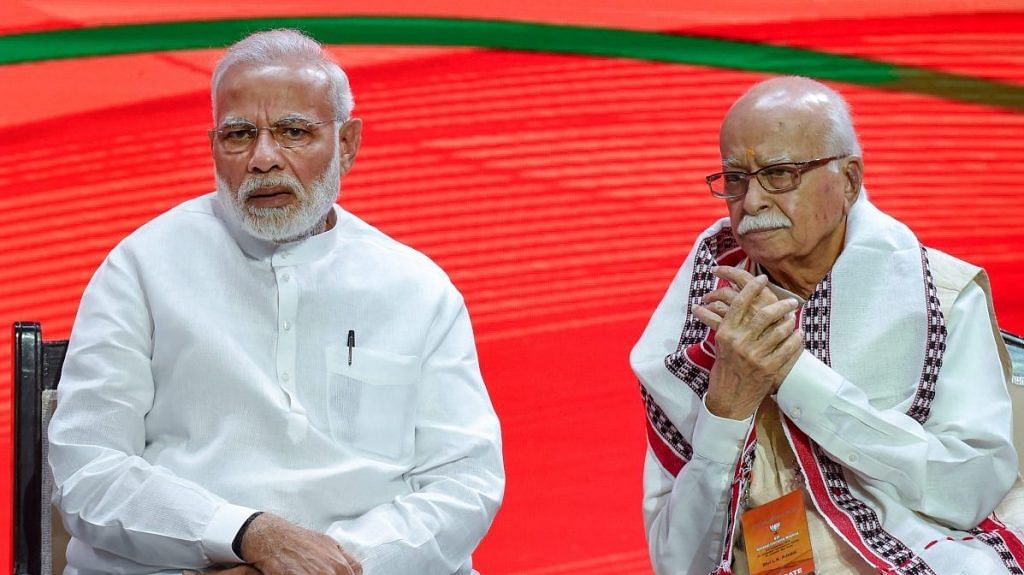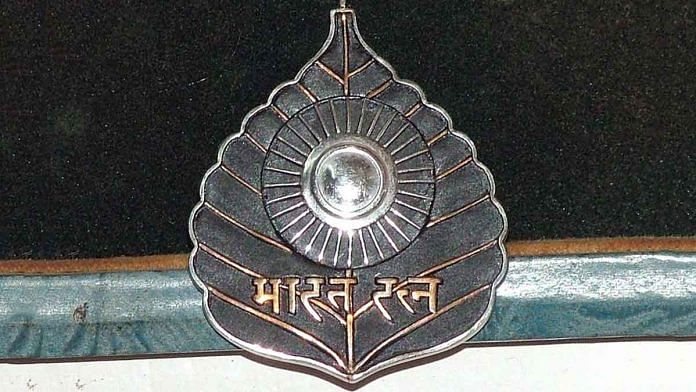The Union government’s decision to confer the Bharat Ratna, the highest civilian award in India, upon the late Karpoori Thakur and Lal Krishna Advani just before the notification of the 2024 Lok Sabha elections is a strong political statement. I see it more as an act of political iconography, which no Indian political formation has ever tried before. I call this a synthesis of Mandir and Mandal politics.
Karpoori Thakur and LK Advani represent two ideological poles of Indian politics. Thakur was one of the most vibrant and potent symbols of social justice in North India, loved by the underclass and hated by the dominant upper castes at the same time. The former Bihar chief minister was known for implementing reservations in government jobs for the backward and extremely backward classes in the state. He did many things and devised many policies for the empowerment of the poor and downtrodden. He was also an icon of secular politics.
In contrast, Advani is the biggest icon of the Ram Temple movement, which catapulted the BJP to the forefront after the rout of the 1984 general elections, where only two of its candidates won. He is associated with the Hindu resurgence in Indian politics.
For a brief period, Thakur and Advani shared the same political space when the Bharatiya Jana Sangh and the Socialist Party merged into the Janata Party to defeat Indira Gandhi. Advani became the Union information and broadcasting minister in the Janata Party government led by Morarji Desai, whereas Thakur became the Chief Minister of Bihar under the same banner. Ex-Jana Sangh leader Kailashpati Mishra became the finance minister in Thakur’s cabinet.

But the Jana Sangh and the socialists soon realised that the glue provided by anti-Congressism was not a sufficient binding force to keep them together. And the Janata Party experiment failed.
The big rupture came in 1990 when the BJP-supported VP Singh government implemented the Mandal Commission report and gave reservation to the Other Backward Classes (OBCs). On 7 March 1990, the Union government announced that 27 per cent central government jobs would be reserved for the OBCs. On 25 September 1990, Advani started the Ram Rath Yatra and, soon thereafter, was arrested in Bihar by the Lalu Prasad government. The BJP withdrew support at the Centre and the government fell.
Also Read: Why Bharat Ratna is key to BJP’s ‘Karpoori-kamandal’ ploy to stump Nitish & INDIA in LS polls
Era of Mandal vs Mandir
The debate is still ongoing about whether the Rath Yatra was in response to the Mandal Report implementation or a standalone decision since it is difficult to prove causality. But what is not in doubt is that the Rath Yatra came just after the announcement of giving 27 per cent of government jobs to the OBCs. So, one can argue that the Mandir issue was pushed to the centrestage to counter the Mandal phenomenon because it had the potential to disrupt the hierarchical Hindu social order and the domination of the Savarna or upper castes.
At this juncture, Mandal and Mandir emerged as two distinct streams of Indian polity, often in contestation and sometimes in confrontation with each other. This binary dynamic played out more emphatically and prominently after the demolition of the Babri Masjid in December 1992, especially in Uttar Pradesh and unified Bihar, which together accounted for 134 Lok Sabha seats in the house of 543 elected members.
The electoral fallout of this phenomenon, Mandal vs Mandir, was profound:
– The parties professing social justice, or the Mandal parties, got stronger in the region, to the extent that the BJP lostthe UP elections in 1993.
– The Congress was marginalised. In Bihar and UP, the Congress was reduced to the fourth or fifth party and still struggled to expand its base.
– The BJP got enough traction to become a permanent fixture of Indian polity.
While the temple movement and related Hindutva agendas, such as Article 370, the Uniform Civil Code, and the ban on cow slaughter, played a role in the BJP’s rise as a major political force, the party did not come to power at the Centre on its own until 2014. So, the pertinent question is, what changed in 2014?
The Mandalisation of the BJP
The BJP’s earlier avatar, the Jana Sangh, was associated more with the Brahmins and Banias of the North and with the refugees who came from Pakistan. The first big transformation in the social composition of the party came during the Ram Temple movement in the late 1980s and early 1990s when leaders like Kalyan Singh, Uma Bharti, Vinay Katiyar, Sadhvi Ritambhara, Shivraj Singh Chouhan, and Babulal Gaur, etc came to the forefront. This process was articulated as “social engineering” by the former BJP general secretary Govindacharya. However, the top leadership remained with figures like Atal Bihari Vajpayee, Advani, Pramod Mahajan, Vijaya Raje Scindia, Madan Lal Khurana, Vijay Kumar Malhotra, Rajnath Singh, Kailashpati Mishra, Kalraj Mishra, and others.

The second transformation came after the BJP’s defeat in the 2009 Lok Sabha elections. Advani and the old guard failed to deliver in that electoral battle, paving the way for the rise of Narendra Modi. Thus began the second stage of social engineering in the BJP, and Modi, professing his OBCness, became the face of the party. The RSS started an outreach programme on a massive scale, especially targeting the OBCs to bring them into the Hindutva fold. As I mentioned in an earlier article, this was perfectly in line with the Savarkarite model of Hindutva, which envisaged forging a grand Hindu unity to leverage against the Muslims.
But this is easier said than done. In the traditional Hindu social order, castes are always in confrontation with each other. The antipathy and animosity are too deep to be covered by just demagogy or rhetoric.
So, how is the BJP able to bring the upper castes, OBCs, and a section of Scheduled Castes together? And what happened to the contradictions and conflicts?
The BJP, at this juncture, is working on twin strategies. It is giving representation to the OBCs and SCs in the political arena, but at the same time, bureaucratic control and business remain with the upper castes. Hence, the rise of the subaltern is not threatening the dominance of the upper castes in their own domains. They only have to cede some space in the political arena. Funny as it may sound, this is the sacrifice they are making to keep the Muslims in control! To assure the upper castes that everything is good, the previous Modi government gave 10 per cent reservation to the economically weaker sections (EWS) in the general category.
However, it also made the OBC Commission a constitutional body and implemented OBC reservations from the all-India quota in NEET as well as Navodaya and Sainik schools. Further, it started the Vishwakarma Yojana for artisans, primarily targeted at the OBCs. The scheme has an annual budget of Rs 13,000 crore.
Last but not least, the BJP remains focused on communal religious issues, the most potent glue of Hindu society. The Union government has banned and criminalised triple talaq, the Ram Temple has been built, and Jammu and Kashmir has been fully integrated with the union and bifurcated. The latter was an administrative decision but it can also be seen as a response (badla or revenge) to the forced exodus of the Kashmiri Pandits in the 1990s. The emotional quotient of such actions is not easy to fathom. The noise around ‘love jihad’ may sound very communal, but for a Hindu family, it can be seen as protecting their daughters from Muslim boys! These things can mean different things to different sets of people.
Also Read: Bharat Ratna is a political tool. Modi using it to position BJP as a social justice party
Congress missed the bus, BJP is riding two
The BJP is in a position to offer different things to the upper castes and the OBCs. Meanwhile, the original Hindu Party of India, the Indian National Congress, has abandoned its core Hindu ideas like Ram Rajya, Vande Mataram, and ritualism, etc., long ago. Pandit Nehru and Indira Gandhi never gave the Jana Sangh the opportunity to flourish. We must not forget that the Indira Gandhi government issued a commemorative stamp honouring Savarkar and called him a remarkable son of India. The last time that the Congress tried to be overtly Hindu was in 1986 when Rajiv Gandhi decided to open the temple gates at Ayodhya and started his election campaign from the holy city. The present-day Congress has become something else.
At the same time, the Congress was the anti-social justice party. In 1990, when VP Singh announced that 27 percent of jobs would go to the OBCs, Rajiv Gandhi gave a lengthy speech against the Mandal Commission. So, the Congress lost ground on both the big political currents of our time: Mandir and Mandal. Conversely, the BJP is riding two buses at the same time. At this juncture, we don’t know how long the BJP will be able to do these gymnastics. But at least for now, it is managing with ease.
With this frame in mind, one can easily understand why the Narendra Modi government conferred the Bharat Ratna on Karpoori Thakur and LK Advani.
Dilip Mandal is the former managing editor of India Today Hindi Magazine, and has authored books on media and sociology. He tweets @Profdilipmandal. Views are personal.
(Edited by Asavari Singh)






